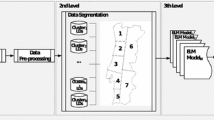Abstract
In this paper we apply a novel smooth component analysis algorithm as ensemble method for prediction improvement. When many prediction models are tested we can treat their results as multivariate variable with the latent components having constructive or destructive impact on prediction results. We show that elimination of those destructive components and proper mixing of those constructive can improve the final prediction results. The validity and high performance of our concept is presented on the problem of energy load prediction.
Preview
Unable to display preview. Download preview PDF.
Similar content being viewed by others
References
Breiman, L.: Bagging predictors. Machine Learning 24, 123–140 (1996)
Cardoso, J.F.: High-order contrasts for independent component analysis. Neural Computation 11, 157–192 (1999)
Choi, S., Cichocki, A.: Blind separation of nonstationary sources in noisy mixtures. Electronics Letters 36(9), 848–849 (2000)
Cichocki, A., Amari, S.: Adaptive Blind Signal and Image Processing. John Wiley, Chichester (2002)
Donoho, D.L., Elad, M.: Maximal Sparsity Representation via l1 Minimization. The Proc. Nat. Acad. Sci. 100, 2197–2202 (2003)
Golub, G.H., Van-Loan, C.F.: Matrix Computations. Johns Hopkins, Baltimore (1996)
Haykin, S.: Neural nets: a comprehensive foundation. Macmillan, NY (1994)
Hoeting, J., Mdigan, D., Raftery, A., Volinsky, C.: Bayesian model averaging: a tutorial. Statistical Science 14, 382–417 (1999)
Hurst, H.E.: Long term storage capacity of reservoirs. Trans. Am. Soc. Civil Engineers 116 (1951)
Hyvärinen, A., Karhunen, J., Oja, E.: Independent Component Analysis. John Wiley, Chichester (2001)
Lendasse, A., Cottrell, M., Wertz, V., Verdleysen, M.: Prediction of Electric Load using Kohonen Maps – Application to the Polish Electricity Consumption. In: Proc. Am. Control Conf. Anchorage AK, pp. 3684–3689 (2002)
Lee, D.D., Seung, H.S.: Learning of the parts of objects by non-negative matrix factorization. Nature, 401 (1999)
Mitchell, T.: Machine Learning. McGraw-Hill, Boston (1997)
Scales, L.E.: Introduction to Non-Linear Optimization. Springer, NY (1985)
Stone, J.V.: Blind Source Separation Using Temporal Predictability. Neural Computation 13(7), 1559–1574 (2001)
Szupiluk, R., Wojewnik, P., Zabkowski, T.: Model Improvement by the Statistical Decomposition. In: Rutkowski, L., Siekmann, J.H., Tadeusiewicz, R., Zadeh, L.A. (eds.) ICAISC 2004. LNCS (LNAI), vol. 3070, pp. 1199–1204. Springer, Heidelberg (2004)
Therrien, C.W.: Discrete Random Signals and Statistical Signal Processing. Prentice Hall, New Jersey (1992)
Yang, Y.: Adaptive regression by mixing. Journal of American Statistical Association, 96 (2001)
Zibulevsky, M., Kisilev, P., Zeevi, Y.Y., Pearlmutter, B.A.: BSS via multinode sparse representation. Adv. in Neural Information Proc. Sys. 14, 185–191 (2002)
Author information
Authors and Affiliations
Editor information
Rights and permissions
Copyright information
© 2007 Springer-Verlag Berlin Heidelberg
About this paper
Cite this paper
Szupiluk, R., Wojewnik, P., Ząbkowski, T. (2007). Smooth Component Analysis as Ensemble Method for Prediction Improvement. In: Davies, M.E., James, C.J., Abdallah, S.A., Plumbley, M.D. (eds) Independent Component Analysis and Signal Separation. ICA 2007. Lecture Notes in Computer Science, vol 4666. Springer, Berlin, Heidelberg. https://doi.org/10.1007/978-3-540-74494-8_35
Download citation
DOI: https://doi.org/10.1007/978-3-540-74494-8_35
Publisher Name: Springer, Berlin, Heidelberg
Print ISBN: 978-3-540-74493-1
Online ISBN: 978-3-540-74494-8
eBook Packages: Computer ScienceComputer Science (R0)




